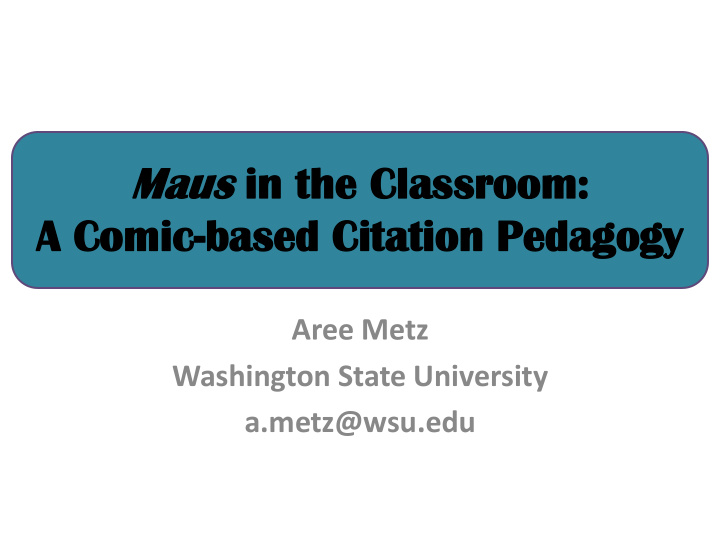



Mau aus in in th the C e Clas assroom sroom: : A A Comi mic-based based Cit itat ation ion Pe Pedag agogy ogy Aree Metz Washington State University a.metz@wsu.edu
A Pedagogy of Multiliteracies “We argue that literacy pedagogy now must account for the burgeoning variety of text forms associated with information and multimedia technologies. This includes understanding and competent control of representational forms that are becoming increasingly significant in the overall communications environment, such as visual images and their relationship to the written word ” New London Group, “A Pedagogy of Multiliteracies : Designing Social Futures”. Harvard Educational Review . 66.1. (1996): Web .
Comic “Narrative Sequences”
Maus: My Father Bleeds History
Goals for students • To consider sources as a whole – To avoid quote-mining • To see the benefits and disadvantages of using direct quotes, paraphrase, summary – Particularly to emphasize the benefits of using paraphrase and summary – Results of the Citation Project (2011): Lots of quotation (42%), less summary (6%) and some paraphrasing (32%) • To understand the importance of contextualizing direct quotes, paraphrase, and summary • To learn and practice integrating sources into their writing in meaningful and creative ways
Direct Quoting Activity
Direct Quoting Activity Cont. • Place card #1 in front #1 of your comic sequence and card #2 at the end of it. • When we use direct quotes in our writing, it is effective to follow a pattern like this: introduce the quote, place the quote, explain why the quote is #2 significant.
Paraphrasing Activity
Summarizing Activity
Student Reflection • What are the benefits of using direct quotes/paraphrase/summary? • What are the disadvantages? • Quotations: “[often] too long and include unnecessary information which is a waste of space” • Paraphrase: “can more easily be integrated into writer’s work (style) and use [multiple] sources” • Paraphrase and Summary as ethos-building: “it looks like the author is diligent […] and spent hours researching”
Trends in Student Papers: First paper with sources • Quotes (15%) – Few quotations • Technological constraints? – Quoted text from speech and thought bubbles • Contextualized using paraphrase – Single-page panels quoted as well as fragments of narrative sequences • Paraphrase (34%) – Paraphrase of single panels, sequences of panels, narrative sequences • Summary (51%) – Usually of a particular section of the graphic novel (chapters, particular storylines, etc.)
Trends in Student Papers: Independent research paper • Quotes (24%) – More than the previous paper – In most papers, quotation did not dominate – Fragmented quotations included with paraphrase/summary • Paraphrase (59%) – Lots of paraphrase • Summary (17%) – Not many full-text summaries – Lots of section summaries and multiple-paragraph summaries • “Narrative sequence” summaries?
Conclusions • Do I think comics help students learn how to use sources in meaningful ways? – Yes, but I think that instructors still need to reinforce citation strategies in class and in feedback • Would I use comics again? – Yes, but perhaps not Maus in particular – Would like to see applications of comics in a FYC class
Th Than ank k Yo You Aree Metz Washington State University a.metz@wsu.edu
Recommend
More recommend